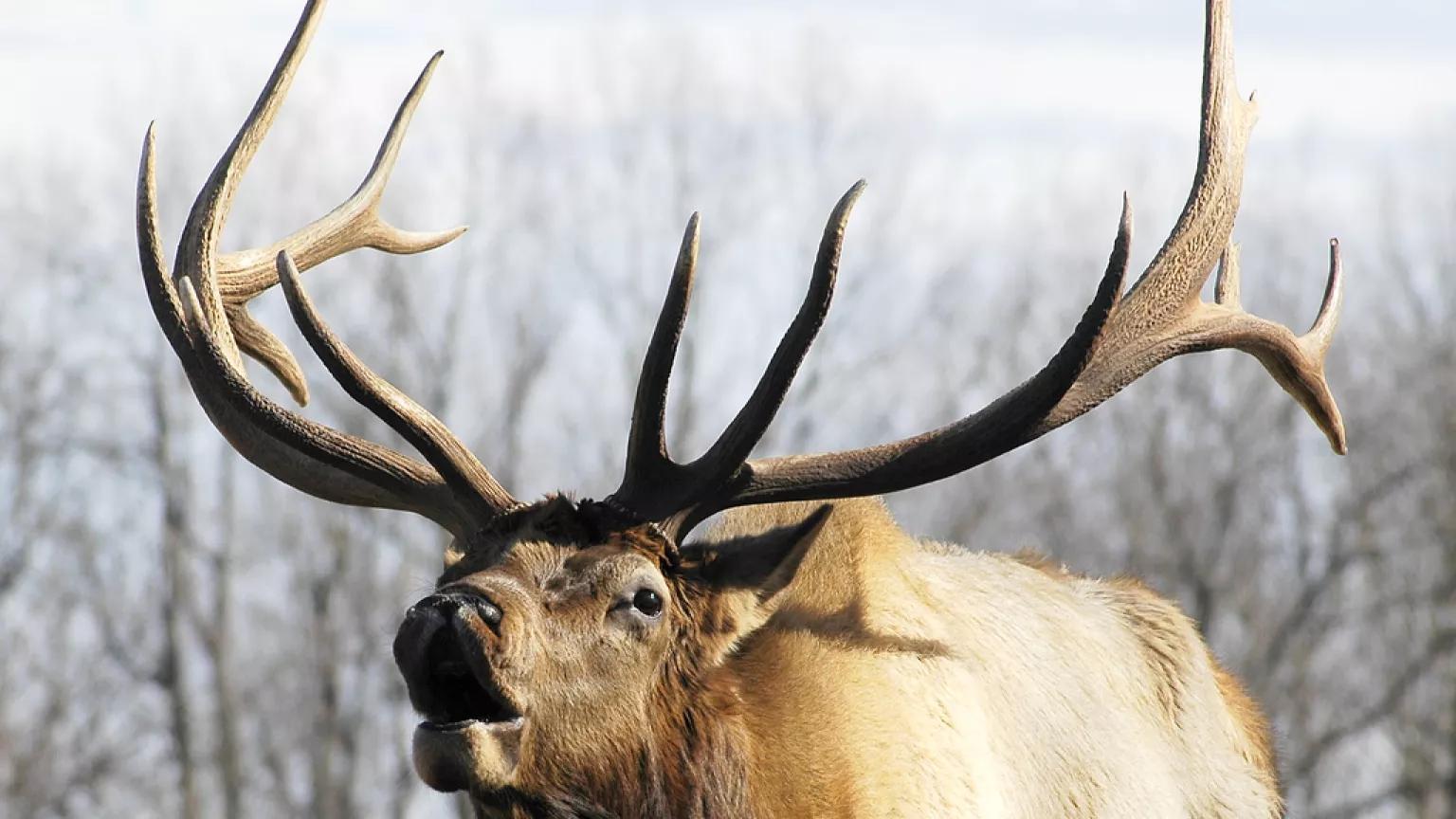The Call of the Bugle
This spring elk from Kentucky will be migrating (by truck) to Wisconsin.

Just after New Year’s, an eight-foot-high cage arose in a Kentucky forest. A door on one side was set to swing shut as soon as a hoof came along and tripped a wire. In the center of the enclosure sat hay and corn laced with something called “buck candy,” sweet stuff that deer love. It also attracts elk—the intended quarry.
After succumbing to the scent of the buck candy, 28 elk wandered into the trap over the following month. In the spring, these antlered ungulates will be whisked away to Wisconsin, where conservationists hope the animals will start a new herd as part of an ongoing restoration effort. Elk once ranged over most of North America, including 50 of Wisconsin’s 72 counties. In the late 1880s, however, hunting and habitat destruction sent the species packing.
Now the Badger State wants them back—and the Bluegrass State is helping out. Over the next five years, 150 elk from a disease-free herd in southeastern Kentucky will be heading north.
“Elk are spectacular animals,” says Kevin Wallenfang, a big-game ecologist from Wisconsin's Department of Natural Resources who leads the reintroduction effort. He’s looking forward to hearing the elk’s whistle-like bugles across the northern half of the state: “To me it screams wilderness.”
The now-20-year-old elk program is Wisconsin’s second try. The state attempted to bring the animals back in the 1930s, but poachers made short work of the hoven participants.
In 1995, wildlife managers sent 25 elk from Canada to Clam Lake in northwestern Wisconsin, where 160 of the beautiful beasts now roam, rut, and bugle across 1,600 square miles. But the population isn’t growing as fast as predicted, due partly to lack of genetic diversity, wolves, and the political landscape between environmentalists and the timber industry.
Clam Lake sits within Chequamegon National Forest, once known as “the hardest-working forest in the country,” because it produced more lumber than any other U.S. woodland. Turns out, elk and logging go pretty well together. The saplings and young trees of a second-growth forest make perfect elk food. But a movement to conserve the forest has helped cut the amount of logging there by nearly half. By protecting the old trees, the smaller, tasty ones became fewer in number. It’s hard to complain about saving a forest, but now the elk need better munching grounds.
Although the reintroduction is off to a slow start, Wisconsin is committed to making it work—and the public is all in. Tourists from all over come every year to hear the elk bugle during the fall rut. The draw is a financial boon for Clam Lake, and if the state can sustain larger herds, hunting could bring in money, too. The ultimate goal is to have close to 2,000 elk in Wisconsin.
And this spring’s new batch from the south will be headed to a different patch of forest in the central part of the state, one with plenty of good grazing.
About 200 miles south of Clam Lake, the Jackson County Wildlife Fund’s Al Jacobson has been pushing for elk at Black River Falls for the last 17 years. His group, as well as a number of other organizations—including the Rocky Mountain Elk Foundation and the Ho-Chunk Nation—raised money to help bolster Wallenfang’s program.
“For once we’re going to be able to tell the residents, citizens, and businesses that ask us when they’re coming that they’re going to be here by the end of March,” says Jacobson. “And we’re really excited about it.”
Tourists in Wisconsin can already get glimpses of bears, wolves, bobcats, mountain lions, otters, fisher cats, and whooping cranes. Adding elk? Well, that is just music to their ears.
This article was originally published on onEarth, which is no longer in publication. onEarth was founded in 1979 as the Amicus Journal, an independent magazine of thought and opinion on the environment. All opinions expressed are those of the authors and do not necessarily reflect the policies or positions of NRDC. This article is available for online republication by news media outlets or nonprofits under these conditions: The writer(s) must be credited with a byline; you must note prominently that the article was originally published by NRDC.org and link to the original; the article cannot be edited (beyond simple things such grammar); you can’t resell the article in any form or grant republishing rights to other outlets; you can’t republish our material wholesale or automatically—you need to select articles individually; you can’t republish the photos or graphics on our site without specific permission; you should drop us a note to let us know when you’ve used one of our articles.

These Prehistoric Fish Are Making a Slow Comeback in the Midwest
The Petcoke Problem: Where to Store the Risky Tar Sands Refining By-Product
Protecting Biodiversity Means Saving the Bogs (and Peatlands, Swamps, Marshes, Fens…)